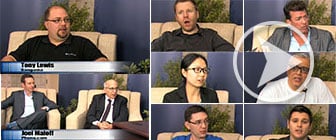|

NASA Takes to Kansas Skies to Study Nighttime Thunderstorms
WASHINGTON, July 1, 2015 /PRNewswire-USNewswire/ -- NASA has joined a multi-agency field campaign studying summer storm systems in the U.S. Great Plains to find out why they often form after the sun goes down instead of during the heat of the day.
The Plains Elevated Convection at Night, or PECAN, project began June 1 and continues through mid-July. Participants from eight research laboratories and 14 universities are collecting storm data to find out how and why they form. NASA's DC-8 airborne laboratory began research flights Tuesday from the Salina Regional Airport, Salina, Kansas.
"We're hoping to collect measurements that will be used to characterize the atmosphere ahead of these storms," said Richard Ferrare, senior research scientist in the Atmospheric Sciences Division at NASA's Langley Research Center, Hampton, Virginia. "If we can map the water vapor that goes into these storms, we'll be able to improve computer models that represent these conditions and better predict the storms."
The NASA DC-8 and National Oceanic and Atmospheric Administration (NOAA) P-3 Orion research aircraft supporting the PECAN mission will be open to the media from 3 to 5 p.m. CDT on Saturday, July 11, at the Salina Regional Airport. The airport is located at 3237 Arnold Avenue.
Unlike othe parts of the United States, summer thunderstorms across the Great Plains are most common after sunset. Much of the rain comes from medium-size weather systems and resulting thunderstorms known as mesoscale convective systems. These nighttime storms can produce heavy rainfall that contributes a significant portion of the yearly precipitation in the region.
Scientists understand that thunderstorms that form during the day result from a vertical "convective" circulation driven by rising warm air from the heated Earth's surface and falling air cooled at higher latitudes in the atmosphere. Less well understood are the mechanisms that cause thunderstorms after the sun has gone down and the land surface has cooled.
The DC-8 carries atmospheric science instruments and investigators from Langley; NASA's Jet Propulsion Laboratory, Pasadena, California; and several universities and research labs. NASA's Goddard Space Flight Center in Greenbelt, Maryland, is providing a ground-based Doppler radar system.
PECAN is funded by the National Science Foundation with additional support from NASA, the National Oceanic and Atmospheric Administration (NOAA), the National Center for Atmospheric Research in Boulder, Colorado, and the Department of Energy.
In addition to the NASA and NOAA aircraft, researchers will receive data from a University of Wyoming King Air plane, ground-based instruments, weather balloons and mobile radars. Storm information will continue to be gathered from multiple agency ground and air instruments across northern Oklahoma, central Kansas, and south-central Nebraska through July.
The DC-8 is based at NASA's Armstrong Flight Research Facility in Palmdale, California, and supports NASA's Airborne Science Program under the Science Mission Directorate. The extended range, prolonged flight-duration capability, large payload capacity, and laboratory environment of the DC-8 make it one of the premier aircraft available for NASA Earth science investigations.
NASA researchers collect and study data from space, air, land and sea to tackle challenges facing the world today, including improved environmental prediction and natural hazard and climate change preparedness. NASA develops new ways to observe and study Earth's interconnected natural systems with long-term data records. The agency freely shares this unique knowledge and works with institutions around the world to gain new insights into how our planet is changing.
Logo - http://photos.prnewswire.com/prnh/20081007/38461LOGO
To view the original version on PR Newswire, visit:http://www.prnewswire.com/news-releases/nasa-takes-to-kansas-skies-to-study-nighttime-thunderstorms-300107798.html
SOURCE NASA

[ Back To Mobile World Congress's Homepage ]
|

 Internet Telephony Magazine
Click here to read latest issue
Internet Telephony Magazine
Click here to read latest issue CUSTOMER
CUSTOMER  Cloud Computing Magazine
Click here to read latest issue
Cloud Computing Magazine
Click here to read latest issue IoT EVOLUTION MAGAZINE
IoT EVOLUTION MAGAZINE













